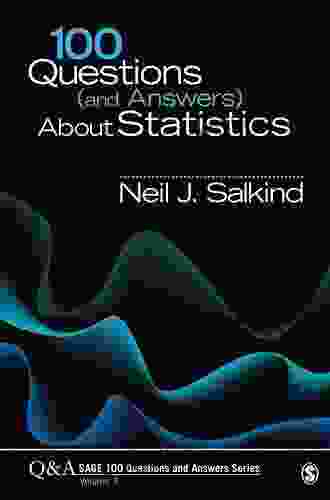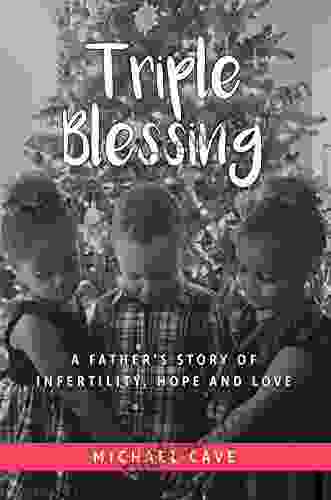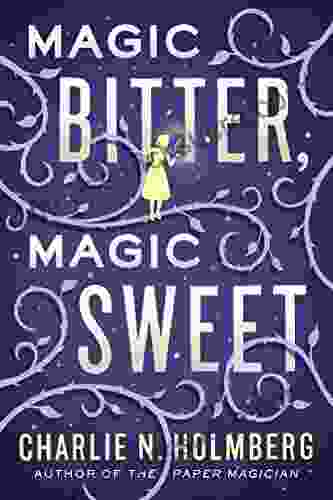100 Questions and Answers About Statistics: Sage 100 Questions and Answers

Statistics is a vast and complex subject, but it's also essential for anyone who wants to understand the world around them. Statistics is used in every field, from business and economics to science and medicine. It helps us to make sense of data, draw s, and make predictions.
This article provides 100 questions and answers about statistics, covering everything from basic concepts to more advanced topics. Whether you're a student just starting to learn about statistics or a seasoned professional looking to brush up on your knowledge, this article has something for you.
4.5 out of 5
| Language | : | English |
| File size | : | 3299 KB |
| Text-to-Speech | : | Enabled |
| Screen Reader | : | Supported |
| Enhanced typesetting | : | Enabled |
| Word Wise | : | Enabled |
| Print length | : | 230 pages |
What is statistics?
Statistics is the science of collecting, analyzing, interpreting, and presenting data. It is used to make inferences about a population based on a sample. Statistics is used in a wide variety of fields, including business, economics, science, and medicine.
What are the different types of statistics?
There are two main types of statistics: descriptive statistics and inferential statistics. Descriptive statistics describe the data that has been collected. Inferential statistics make inferences about a population based on a sample.
What are the basic concepts of statistics?
The basic concepts of statistics include:
- Data: Data is the information that is collected. Data can be quantitative or qualitative.
- Variables: Variables are the characteristics of the data that are being studied.
- Population: The population is the entire group of individuals or objects that are being studied.
- Sample: A sample is a subset of the population that is used to make inferences about the population.
- Parameter: A parameter is a numerical characteristic of the population.
- Statistic: A statistic is a numerical characteristic of the sample.
What are the different methods of data collection?
There are a variety of different methods of data collection, including:
- Surveys: Surveys are a method of data collection that involves asking people questions.
- Experiments: Experiments are a method of data collection that involves manipulating a variable and observing the effects.
- Observational studies: Observational studies are a method of data collection that involves observing a group of people over time.
- Case studies: Case studies are a method of data collection that involves studying a single individual or group of individuals in depth.
What are the different types of data?
There are two main types of data: quantitative data and qualitative data.
- Quantitative data is data that can be expressed in numbers.
- Qualitative data is data that cannot be expressed in numbers.
What are the different levels of measurement?
There are four different levels of measurement:
- Nominal: Nominal data is data that can be categorized into different groups.
- Ordinal: Ordinal data is data that can be ranked in order.
- Interval: Interval data is data that has a fixed distance between the values.
- Ratio: Ratio data is data that has a true zero point.
What are the different types of statistical analysis?
There are a variety of different types of statistical analysis, including:
- Descriptive statistics: Descriptive statistics describe the data that has been collected.
- Inferential statistics: Inferential statistics make inferences about a population based on a sample.
- Regression analysis: Regression analysis is a statistical method that is used to predict the value of one variable based on the values of other variables.
- Hypothesis testing: Hypothesis testing is a statistical method that is used to test the hypothesis that there is no difference between two groups.
What are the different types of statistical software?
There are a variety of different types of statistical software, including:
- SPSS: SPSS is a statistical software program that is used for a variety of statistical analyses, including descriptive statistics, inferential statistics, regression analysis, and hypothesis testing.
- SAS: SAS is a statistical software program that is used for a variety of statistical analyses, including data management, data analysis, and statistical modeling.
- R: R is a free and open-source statistical software program that is used for a variety of statistical analyses, including data visualization, data analysis, and statistical modeling.
- Python: Python is a general-purpose programming language that can be used for a variety of statistical analyses, including data visualization, data analysis, and statistical modeling.
What are the different careers in statistics?
There are a variety of different careers in statistics, including:
- Statistician: Statisticians collect, analyze, and interpret data. They work in a variety of fields, including business, economics, science, and medicine.
- Data scientist: Data scientists use data to solve business problems. They work in a variety of fields, including business, economics, and technology.
- Data analyst: Data analysts use data to identify trends and patterns. They work in a variety of fields, including business, economics, and marketing.
- Quantitative analyst: Quantitative analysts use mathematical and statistical models to make investment decisions. They work in a variety of financial institutions, including investment banks and hedge funds.
Statistics is a powerful tool that can be used to understand the world around us. It is used in every field, from business and economics to science and medicine. This article has provided a brief overview of the field of statistics.
4.5 out of 5
| Language | : | English |
| File size | : | 3299 KB |
| Text-to-Speech | : | Enabled |
| Screen Reader | : | Supported |
| Enhanced typesetting | : | Enabled |
| Word Wise | : | Enabled |
| Print length | : | 230 pages |
Do you want to contribute by writing guest posts on this blog?
Please contact us and send us a resume of previous articles that you have written.
 Fiction
Fiction Non Fiction
Non Fiction Romance
Romance Mystery
Mystery Thriller
Thriller SciFi
SciFi Fantasy
Fantasy Horror
Horror Biography
Biography Selfhelp
Selfhelp Business
Business History
History Classics
Classics Poetry
Poetry Childrens
Childrens Young Adult
Young Adult Educational
Educational Cooking
Cooking Travel
Travel Lifestyle
Lifestyle Spirituality
Spirituality Health
Health Fitness
Fitness Technology
Technology Science
Science Arts
Arts Crafts
Crafts DIY
DIY Gardening
Gardening Petcare
Petcare Diana Hudson
Diana Hudson Romina Garber
Romina Garber Kathy Barker
Kathy Barker Alice Scordato
Alice Scordato Stephen Blyth
Stephen Blyth Martha Shirk
Martha Shirk David A Askay
David A Askay Jen Noonan
Jen Noonan Erez Morabia
Erez Morabia Adah Bakalinsky
Adah Bakalinsky Carolyn Highland
Carolyn Highland Hans Rosling
Hans Rosling Tracy Anderson
Tracy Anderson Jessica Goodman
Jessica Goodman Nick Mitchell
Nick Mitchell Lauren Drain
Lauren Drain Michaelbrent Collings
Michaelbrent Collings Les Adams
Les Adams Mark C Purcell
Mark C Purcell Tracy Becker
Tracy Becker Jeff Sambur
Jeff Sambur Paul H Frampton
Paul H Frampton Brent Warner
Brent Warner Jessica Riskin
Jessica Riskin Michael Vassallo
Michael Vassallo Executivegrowth Summaries
Executivegrowth Summaries Kevin Allen
Kevin Allen Rachel Vitale
Rachel Vitale Grackle Pigeon
Grackle Pigeon Joshua R Eyler
Joshua R Eyler Laura Katz
Laura Katz Doc Norton
Doc Norton Peter J Hotez
Peter J Hotez Alice Jolly
Alice Jolly Sue Tidwell
Sue Tidwell Gordon England
Gordon England Robin G Jordan
Robin G Jordan Nancy Roe Pimm
Nancy Roe Pimm Peter Gandy
Peter Gandy Daniel Goleman
Daniel Goleman Dianna L Van Blerkom
Dianna L Van Blerkom Mitchell P Jones
Mitchell P Jones Oivind Andersson
Oivind Andersson Pottermore Publishing
Pottermore Publishing Hicham And Mohamed Ibnalkadi
Hicham And Mohamed Ibnalkadi Mike Dauplaise
Mike Dauplaise Matilda Betham
Matilda Betham Helen Hodgson
Helen Hodgson Ian Morris
Ian Morris Richard Preston
Richard Preston Neil Schulenburg
Neil Schulenburg Heather Baker
Heather Baker Mary Cholmondeley
Mary Cholmondeley Patricia A Mckillip
Patricia A Mckillip Chase Kosterlitz
Chase Kosterlitz Frederick Courteney Selous
Frederick Courteney Selous David Wolman
David Wolman Kathleen Mcauliffe
Kathleen Mcauliffe Lynne Robinson
Lynne Robinson Mike Commito
Mike Commito Alice Steinbach
Alice Steinbach C S Johnson
C S Johnson Katie Walsh Flanagan
Katie Walsh Flanagan Alfred Tennyson
Alfred Tennyson Courtney Kenney
Courtney Kenney George S Fichter
George S Fichter Emily Riehl
Emily Riehl Terry Marsh
Terry Marsh Robert L Kelly
Robert L Kelly Scott Weems
Scott Weems Rosary O Neill
Rosary O Neill Nora Roberts
Nora Roberts Kirstin Cronn Mills
Kirstin Cronn Mills Elan Golomb
Elan Golomb Tasha Alexander
Tasha Alexander Charlie N Holmberg
Charlie N Holmberg Dustin Vaughn Warncke
Dustin Vaughn Warncke Sigurd F Olson
Sigurd F Olson Erika Rogers Holland
Erika Rogers Holland Richard Moore
Richard Moore David Maidment
David Maidment Alice Kuipers
Alice Kuipers Jim Vance
Jim Vance Alexandra Bracken
Alexandra Bracken Valora Conciencia En Los Medios
Valora Conciencia En Los Medios Dr C
Dr C Alicia Ranoldo
Alicia Ranoldo Michael J Behe
Michael J Behe Wendy Currie
Wendy Currie Anymom
Anymom Alice Borchardt
Alice Borchardt Alice Miller
Alice Miller Roddy Scheer
Roddy Scheer Philip Rossoni
Philip Rossoni Stacy Tornio
Stacy Tornio Alice June
Alice June Shannon Messenger
Shannon Messenger John Pagano
John Pagano Mark Rippetoe
Mark Rippetoe Beccy Hands
Beccy Hands Carlton Kirby
Carlton Kirby Shaka Senghor
Shaka Senghor David Armitage
David Armitage Damon Centola
Damon Centola Tim Weston
Tim Weston David G Alciatore
David G Alciatore Rin Chupeco
Rin Chupeco Tim Maudlin
Tim Maudlin Stuart Kauffman
Stuart Kauffman Kynan Bridges
Kynan Bridges Darrin Gee
Darrin Gee K T Hanna
K T Hanna Guy Hunter Watts
Guy Hunter Watts Steve Parker
Steve Parker Bob Toski
Bob Toski John Abramson
John Abramson Anna Mathur
Anna Mathur Hape Kerkeling
Hape Kerkeling Complete Test Preparation Inc
Complete Test Preparation Inc Nel Noddings
Nel Noddings Joshua Coleman Phd
Joshua Coleman Phd Randy Spencer
Randy Spencer Ali Katz
Ali Katz Martha Sears
Martha Sears Matthew Silverman
Matthew Silverman Aram Attarian
Aram Attarian Eric Barker
Eric Barker Arno Ilgner
Arno Ilgner Alexey Osadchuk
Alexey Osadchuk Jay Greenberg
Jay Greenberg Alexis L Boylan
Alexis L Boylan Melia Keeton Digby
Melia Keeton Digby Sarah Melland
Sarah Melland Alexandra Robbins
Alexandra Robbins Lara Alcock
Lara Alcock Douglas Starr
Douglas Starr Alice Nobile
Alice Nobile Ben Applebaum
Ben Applebaum Nic Sheff
Nic Sheff Alice Gorman
Alice Gorman Corky Pollan
Corky Pollan Gabriel Aluisy
Gabriel Aluisy Joseph Henrich
Joseph Henrich Ali Novak
Ali Novak Jon Moxley
Jon Moxley David G Kingdon
David G Kingdon Michael Mcteigue
Michael Mcteigue Karen Kovacs
Karen Kovacs M Mitchell Waldrop
M Mitchell Waldrop Daniel Young
Daniel Young Peter Woit
Peter Woit Keisuke Andrew
Keisuke Andrew Crysta Mchenry
Crysta Mchenry Sammy Hagar
Sammy Hagar Adrian Dingle
Adrian Dingle Jermaine Harris
Jermaine Harris Sacha Black
Sacha Black Lauren Harris
Lauren Harris Yehuda Lindell
Yehuda Lindell Ruby Vincent
Ruby Vincent Philip Freeman
Philip Freeman Raymond Barrett
Raymond Barrett Bayo Akomolafe
Bayo Akomolafe John G West
John G West Bjorn Kjellstrom
Bjorn Kjellstrom Veronica O Keane
Veronica O Keane Christopher Mitchell
Christopher Mitchell Mark Sisson
Mark Sisson Alexandra Fuller
Alexandra Fuller Penny Armstrong
Penny Armstrong Ryuu Shinohara
Ryuu Shinohara Alice Cooper
Alice Cooper Mark Zondo
Mark Zondo Craig S Brantley
Craig S Brantley Kathryn A Bard
Kathryn A Bard Jeremy Hance
Jeremy Hance Zac Unger
Zac Unger Karin Slaughter
Karin Slaughter Hank D Haney
Hank D Haney Anders Morley
Anders Morley Leslie Anthony
Leslie Anthony Dean Pohlman
Dean Pohlman Alfred Lambremont Webre
Alfred Lambremont Webre Whitney Miller
Whitney Miller Margaret Starbird
Margaret Starbird Robert Kagan
Robert Kagan William G Tapply
William G Tapply Constantine A Balanis
Constantine A Balanis Wade Davis
Wade Davis Rob Price
Rob Price Matthew Bowling
Matthew Bowling Helen Purperhart
Helen Purperhart Steven Pressfield
Steven Pressfield Lisa Manterfield
Lisa Manterfield Peter D Rogers
Peter D Rogers Patti M Hummel
Patti M Hummel Mike Wallace
Mike Wallace Jodi L Weinstein
Jodi L Weinstein Lawrence Weschler
Lawrence Weschler Jeff Cooper
Jeff Cooper Karyl Rickard
Karyl Rickard Peggy Vincent
Peggy Vincent Glade B Curtis
Glade B Curtis Stephen Altschuler
Stephen Altschuler Dr Heather L Johnson
Dr Heather L Johnson Mario Cleves
Mario Cleves Eric Siegel
Eric Siegel Whitney Ferre
Whitney Ferre John Bemelmans Marciano
John Bemelmans Marciano Karin Perry
Karin Perry Pam Withers
Pam Withers Nancy Carpentier Brown
Nancy Carpentier Brown William King
William King Amanda Ripley
Amanda Ripley Mark Kaplan
Mark Kaplan Scott Chimileski
Scott Chimileski Alexei Yurchak
Alexei Yurchak Alexia Leachman
Alexia Leachman Kev Reynolds
Kev Reynolds Zar Petkov
Zar Petkov Daniel M Davis
Daniel M Davis Alice Beck Kehoe
Alice Beck Kehoe Neil J Salkind
Neil J Salkind Minda Harts
Minda Harts Ali Wong
Ali Wong Mark Elbroch
Mark Elbroch Alexandra Kennon
Alexandra Kennon Charles Hainsworth
Charles Hainsworth Crystal Waltman
Crystal Waltman Matthew Dektas
Matthew Dektas Andrew Zimmern
Andrew Zimmern Stephanie Mitchell Cnm Msn Dnp
Stephanie Mitchell Cnm Msn Dnp John Lohn
John Lohn Frank C Hawkins
Frank C Hawkins Tom Mackie
Tom Mackie Sam Thoma
Sam Thoma Alfie Kohn
Alfie Kohn David J Rothman
David J Rothman Dawn Brookes
Dawn Brookes Richard H Coop
Richard H Coop Mary Kay Andrews
Mary Kay Andrews Alice Walker
Alice Walker Dan Aadland
Dan Aadland Emma Lock
Emma Lock Jean Chatzky
Jean Chatzky Frank White
Frank White David J Goldman
David J Goldman Jim Walden
Jim Walden Robert Zimmerman
Robert Zimmerman Mark Harris
Mark Harris Ernie Palladino
Ernie Palladino Ally Nathaniel
Ally Nathaniel Ellen Kane
Ellen Kane Dylan Farrow
Dylan Farrow Suzanne Giesemann
Suzanne Giesemann Laura Gauld
Laura Gauld David Byrne
David Byrne Dagny Scott Barrios
Dagny Scott Barrios Jack Batten
Jack Batten Paige Wolf
Paige Wolf Sarah A Chrisman
Sarah A Chrisman David Gessner
David Gessner Aris Spanos
Aris Spanos Bear Grylls
Bear Grylls Jayson Georges
Jayson Georges Emily Levesque
Emily Levesque Ali Velez Alderfer
Ali Velez Alderfer Alice Sebold
Alice Sebold John F Gilbey
John F Gilbey Susan Albers
Susan Albers Hollie Henderson
Hollie Henderson Michael Patrick Ghiglieri
Michael Patrick Ghiglieri Thomas Hund
Thomas Hund Roland Huntford
Roland Huntford Peter Stark
Peter Stark Thomas Horn
Thomas Horn Shaun David Hutchinson
Shaun David Hutchinson Eric Mantle
Eric Mantle Michelle Rotteau
Michelle Rotteau Malina Malkani Ms Rdn Cdn
Malina Malkani Ms Rdn Cdn Nick Littlehales
Nick Littlehales Alfred Edersheim
Alfred Edersheim Lindsay Grace
Lindsay Grace David A Ebert
David A Ebert David Watson
David Watson Milly Buonanno
Milly Buonanno Gary A Klein
Gary A Klein Judith Levin
Judith Levin Yvette Marquez Sharpnack
Yvette Marquez Sharpnack Devyn Stone
Devyn Stone Duncan Hines
Duncan Hines Ken Mink
Ken Mink Michael Clark
Michael Clark Alexia Purdy
Alexia Purdy Lola Glass
Lola Glass Chip K
Chip K Susan Jules
Susan Jules Jane Gildart
Jane Gildart Jonathan Carroll
Jonathan Carroll Jenna Ortega
Jenna Ortega Patrick Ness
Patrick Ness Heather Lang
Heather Lang Ashley Mardell
Ashley Mardell Stacey L Bradford
Stacey L Bradford Penelope Freed
Penelope Freed Judy Murray
Judy Murray Gen Tanabe
Gen Tanabe Krissy Moehl
Krissy Moehl David R Hawkins
David R Hawkins Sir Oliver Lodge
Sir Oliver Lodge Eric Kaplan
Eric Kaplan Peter Collier
Peter Collier Jim Mclean
Jim Mclean Alfred Tarski
Alfred Tarski Brigid Moss
Brigid Moss Frank J Tipler
Frank J Tipler Normandi Ellis
Normandi Ellis Li Ming Lee
Li Ming Lee Udo Schaefer
Udo Schaefer Alice Horton
Alice Horton Jessica Long
Jessica Long Rev Cain
Rev Cain Peter Flom
Peter Flom Lonely Planet
Lonely Planet Arthur Ashe
Arthur Ashe Lynne Cox
Lynne Cox Ali Almossawi
Ali Almossawi Samantha Cattach
Samantha Cattach Paul Stephenson
Paul Stephenson Robert Scott
Robert Scott Robin Kaplan M Ed Ibclc
Robin Kaplan M Ed Ibclc Reina Donovan
Reina Donovan Dan Jenkins
Dan Jenkins Heinrich Cornelius Agrippa Von Nettesheim
Heinrich Cornelius Agrippa Von Nettesheim German Raigosa
German Raigosa Matthew Cowsert
Matthew Cowsert Jonny Bowden
Jonny Bowden Amy Pickar Abernethy
Amy Pickar Abernethy Louis Borgenicht
Louis Borgenicht Michael Vlessides
Michael Vlessides Mary Johnson
Mary Johnson Becca Maberly
Becca Maberly Theodore Roosevelt
Theodore Roosevelt Natalie Angier
Natalie Angier Joe Proulx
Joe Proulx Jason Selk
Jason Selk Alfred North Whitehead
Alfred North Whitehead Said Hasyim
Said Hasyim Jill Simonian
Jill Simonian Alexis C Bunten
Alexis C Bunten Thao Doan
Thao Doan Bassem R Mahafza
Bassem R Mahafza Eileen Edna Power
Eileen Edna Power Erica Lyon
Erica Lyon Brian D Ambrosio
Brian D Ambrosio Ryan Guldberg
Ryan Guldberg Michael R Lindeburg
Michael R Lindeburg Anthony Legins
Anthony Legins Karl Wiegers
Karl Wiegers Norman L Keltner
Norman L Keltner Gary Wayne
Gary Wayne Vicki Manning
Vicki Manning Robert Lusetich
Robert Lusetich Sharon Powell
Sharon Powell Wayne Stewart
Wayne Stewart George Takei
George Takei Patrick Torsell
Patrick Torsell Lara Carter
Lara Carter Alexandra M Levitt
Alexandra M Levitt Michael Thorp
Michael Thorp Alexandra Mayzler
Alexandra Mayzler Alexis Marie Chute
Alexis Marie Chute Andy Kirkpatrick
Andy Kirkpatrick G Pascal Zachary
G Pascal Zachary Pantea Kalhor
Pantea Kalhor Tim R Swartz
Tim R Swartz Robert A Monroe
Robert A Monroe Jay Golden
Jay Golden Alexandria Moran
Alexandria Moran Scott Linden
Scott Linden Alina Adams
Alina Adams Alexey Zimarev
Alexey Zimarev Jonathan Weiner
Jonathan Weiner Deborah Layton
Deborah Layton Paul Green
Paul Green John Madieu
John Madieu Paul Asay
Paul Asay Kimberly V Garner
Kimberly V Garner Lydia Wylie Kellermann
Lydia Wylie Kellermann Eric Layton
Eric Layton Suzy Amis Cameron
Suzy Amis Cameron Michael Cave
Michael Cave Alexis Averbuck
Alexis Averbuck Arthur Lydiard
Arthur Lydiard Joy S Kasson
Joy S Kasson Donna Bozzo
Donna Bozzo Joel Weinberger
Joel Weinberger Frank Amthor
Frank Amthor Jose Albani
Jose Albani Melissa Falkowski
Melissa Falkowski Clay Bonnyman Evans
Clay Bonnyman Evans Avi Gordon
Avi Gordon Joe Dolio
Joe Dolio John Pirillo
John Pirillo Carmindy
Carmindy Michael Johnson
Michael Johnson Heidi Murkoff
Heidi Murkoff Arthur Robert Harding
Arthur Robert Harding Sarah Bolitho
Sarah Bolitho Ted Zeff
Ted Zeff Christopher Steiner
Christopher Steiner Mike Westin
Mike Westin Alfred Begum
Alfred Begum Thomas F King
Thomas F King Howard Pyle
Howard Pyle Malala Yousafzai
Malala Yousafzai Sarah Rayner
Sarah Rayner Elizabeth Clare Prophet
Elizabeth Clare Prophet America S Test Kitchen
America S Test Kitchen Kenn Bivins
Kenn Bivins Nick Kalyn
Nick Kalyn Thomas Hill
Thomas Hill Robert P Crease
Robert P Crease Mikel Jollett
Mikel Jollett Sabina Khan
Sabina Khan Penelope Leach
Penelope Leach Virgil Herring
Virgil Herring Carol Ekarius
Carol Ekarius Lyanda Lynn Haupt
Lyanda Lynn Haupt Alice Boyes Ph D
Alice Boyes Ph D Bernie Clark
Bernie Clark Deborah Laird Meeks
Deborah Laird Meeks Eleanor Drago Severson
Eleanor Drago Severson Josh Peter
Josh Peter Charles Murray
Charles Murray Stephen Ilg
Stephen Ilg Susan Wise Bauer
Susan Wise Bauer Lance Akiyama
Lance Akiyama Roy Barth
Roy Barth Sir E A Wallis Budge
Sir E A Wallis Budge Andrew Yueh
Andrew Yueh Alexandra Heminsley
Alexandra Heminsley Phillip Starr
Phillip Starr David Travis
David Travis Larry Baush
Larry Baush Rails To Trails Conservancy
Rails To Trails Conservancy Henry Gilbert
Henry Gilbert Steve O Hearn
Steve O Hearn Penny Warner
Penny Warner Seabury Blair
Seabury Blair Carmen Martinez Jover
Carmen Martinez Jover Daniel Foor Phd
Daniel Foor Phd Ron Ritchhart
Ron Ritchhart Paul Wilmott
Paul Wilmott Karen Mcquestion
Karen Mcquestion Alexandra Brodsky
Alexandra Brodsky Leslie Berlin
Leslie Berlin Joeanna Rebello Fernandes
Joeanna Rebello Fernandes Karin Bojs
Karin Bojs Vishal Sambharya
Vishal Sambharya John C Hudson
John C Hudson Luke Reynolds
Luke Reynolds Alice Roberts
Alice Roberts Sarah K L Wilson
Sarah K L Wilson Michele Filgate
Michele Filgate Alicia Puglionesi
Alicia Puglionesi Allison Saft
Allison Saft Carol Chaitkin
Carol Chaitkin Mary Beth Knight
Mary Beth Knight George Beinhorn
George Beinhorn Kathy Gunst
Kathy Gunst Jeremy Benson
Jeremy Benson Carl Erskine
Carl Erskine Wendy Wood
Wendy Wood Jerry Lynch
Jerry Lynch Rebecca Schwarzlose
Rebecca Schwarzlose
Light bulbAdvertise smarter! Our strategic ad space ensures maximum exposure. Reserve your spot today!
 T.S. EliotFollow ·13k
T.S. EliotFollow ·13k Troy SimmonsFollow ·19.1k
Troy SimmonsFollow ·19.1k Shane BlairFollow ·14.9k
Shane BlairFollow ·14.9k Jesse BellFollow ·8.7k
Jesse BellFollow ·8.7k Ricky BellFollow ·7.1k
Ricky BellFollow ·7.1k Edison MitchellFollow ·3.9k
Edison MitchellFollow ·3.9k Dean ButlerFollow ·13.8k
Dean ButlerFollow ·13.8k Jackson BlairFollow ·9.2k
Jackson BlairFollow ·9.2k

 Derek Bell
Derek BellReflections For Your Heart and Soul: A Journey of...
In the depths of...

 Joseph Conrad
Joseph ConradThe Heroines Club: Empowering Mothers and Daughters
The Heroines Club...

 Milan Kundera
Milan KunderaThe First Kormak Omnibus: A Literary Expedition into the...
Prepare to embark on an extraordinary literary...

 W.H. Auden
W.H. AudenThe Color Purple: A Journey of Love, Resilience, and...
The Color Purple, a groundbreaking novel...

 Harvey Hughes
Harvey HughesTemporal Anomalies and Replacement Theory: Unraveling the...
: The Enigma of Time Time,...
4.5 out of 5
| Language | : | English |
| File size | : | 3299 KB |
| Text-to-Speech | : | Enabled |
| Screen Reader | : | Supported |
| Enhanced typesetting | : | Enabled |
| Word Wise | : | Enabled |
| Print length | : | 230 pages |














